The Southern Pacific Narrow Gauge
[ Home ] [ Up to Index ] [ Previous Page ] [ Next Page ]
The Slim Princess
| Carson & Colorado |
Nevada & California |
Southern Pacific |
| 1880-1905 |
1905-1912 |
1912-1959 |
The Carson and Colorado Railway was incorporated May 10, 1880 to
build a narrow gauge rail line from Mound House on the Virginia and
Truckee Railroad along the Carson River to a point on the Colorado
River, hence Carson & Colorado. Construction started May 31, 1880
and reached Keeler on Owens Lake July 12, 1883. The first train arrived
at Keeler August 1, 1883.
The railroad was purchased by the Southern Pacific Railroad in March
1900 which continued to operate it as the Carson and Colorado. In
October 1904, the Hazen Cut-off was started as standard gauge and the
narrow gauge track was changed to standard gauge south to Tonopah Jct.,
a few miles south of Mina. The new track was finished in August 1905.
The name of the railroad was changed to Nevada and California Railway
on May 11, 1905. In 1912 the name was again changed to Southern
Pacific.
The narrow gauge line from Mina to Benton was abandoned in 1938, and
from Benton to Laws in 1942. The rest of the line from Laws to Keeler
was abandoned April 30, 1959.
The Southern Pacific standard gauge line from Mojave to Lone Pine
was built between May 1908 and October 1910. The line from Lone Pine to
Searles was abandoned in 1982.
The line was called the "Slim Princess" by the local population.
Until Hwy. 395 was paved and improved along the west side of the Owens
Valley, the Slim Princess was a major transportation resource. However,
it was built to service mineral resources and it ran down the less
habitable east side of the valley. All the "major" population centers
of the Owens Valley are spread out along Hwy. 395 so that it was a long
trip just to get to the railroad.
The Laws Railroad Museum was established at the site of old Laws
depot after abandonment of the railroad. A single 4-6-0 engine and a
string of cars still sit there along with many displays of period
artifacts. If you are ever in the Owens Valley, stop by Laws, its worth
the trip. Another of the narrow gauge engines sits in a park display in
Independence, CA right next to Hwy. 395.
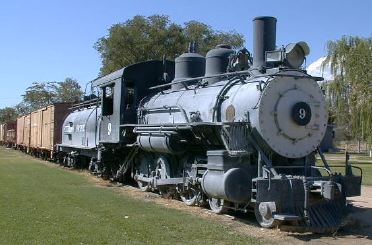 Locomotive No. 9, a 4-6-0, was built by the Baldwin Locomotive
Works, November 1909 for the Nevada-Calif.-Oregon Railway as their No.
9. It was acquired by the Southern Pacific Railroad, September 1, 1929,
rebuilt and put in service on the Owens Valley line Feb. 21 1930 as the
S P No. 9. It was put on stand-by service when the diesel electric
locomotive was put in service, Oct. 1954, was retired when the railroad
was abandoned. The locomotive was donated to the City of Bishop and
moved to Laws for display, April 30, 1960.
Locomotive No. 9, a 4-6-0, was built by the Baldwin Locomotive
Works, November 1909 for the Nevada-Calif.-Oregon Railway as their No.
9. It was acquired by the Southern Pacific Railroad, September 1, 1929,
rebuilt and put in service on the Owens Valley line Feb. 21 1930 as the
S P No. 9. It was put on stand-by service when the diesel electric
locomotive was put in service, Oct. 1954, was retired when the railroad
was abandoned. The locomotive was donated to the City of Bishop and
moved to Laws for display, April 30, 1960.
Locomotive Data
- Builder's Number 34035
- Cylinders are 16" in diameter with a 20" stroke
- Drive wheels are 44" in diameter
- Boiler pressure was 180 pounds
- Tractive effort of 17,800 pounds
- Weighs 87,150 pounds
- Tender has a capacity of 1,800 gals. oil and 3,000 gals. water
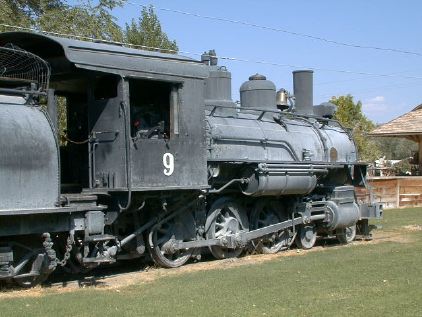 The engine is displayed at the head of a short train of
wood cars. The cab is open to visitors and the bell works fine. Every
kid that climbed in the cab rings the bell.
The engine is displayed at the head of a short train of
wood cars. The cab is open to visitors and the bell works fine. Every
kid that climbed in the cab rings the bell.
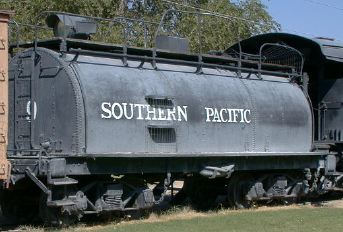 Most SP engines ran on oil as
both wood and coal are rather scarce in the eastern Sierra. SP used the
lowest grade of oil that they could get and these locos smoked heavily
even when fired correctly.
Most SP engines ran on oil as
both wood and coal are rather scarce in the eastern Sierra. SP used the
lowest grade of oil that they could get and these locos smoked heavily
even when fired correctly.
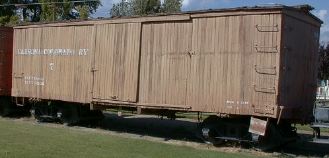 Following the engine in the
display, there is a well preserved wooden boxcar wearing the original
C&C lettering.
Following the engine in the
display, there is a well preserved wooden boxcar wearing the original
C&C lettering.
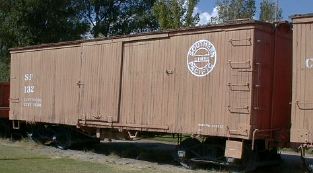 A similar boxcar, this time
lettered for SP, follows the C&C car.
A similar boxcar, this time
lettered for SP, follows the C&C car.
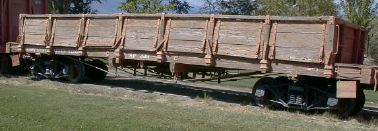 This side dump gondola was the next in line. These cars
were usually used for hauling ballast so that it could be dumped right
at the side of the tracks. The dump doors are as simple as they get.
Between each door is a piece of angle iron that is pivoted at the
center. The piece could be turned to either hold the doors shut or to
prop them open.
This side dump gondola was the next in line. These cars
were usually used for hauling ballast so that it could be dumped right
at the side of the tracks. The dump doors are as simple as they get.
Between each door is a piece of angle iron that is pivoted at the
center. The piece could be turned to either hold the doors shut or to
prop them open.
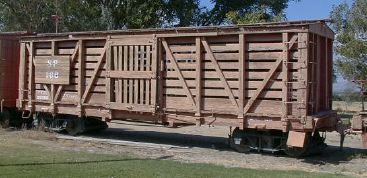 The Slim Princess hauled
livestock that was grazed in the fairly dry ranches of the Owens Valley
north to the railhead at Mound House where the stock could be
transferred to the V&T and eventually to the rest of the SP
system.
The Slim Princess hauled
livestock that was grazed in the fairly dry ranches of the Owens Valley
north to the railhead at Mound House where the stock could be
transferred to the V&T and eventually to the rest of the SP
system.
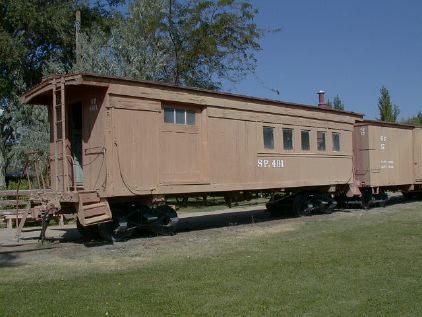 This car was built by the Carter Brothers Manufacturing
Company in 1881 for the San Joaquin and Sierra Nevada Railway, a
Southern Pacific subsidiary, as a baggage-coach for passenger service.
In 1888, it became the property of the Northern Railway, another
Southern Pacific subsidiary, as their number 1009, and in 1904 went to
Southern Pacific's South Pacific Coast Railway still numbered 1009.
This car was built by the Carter Brothers Manufacturing
Company in 1881 for the San Joaquin and Sierra Nevada Railway, a
Southern Pacific subsidiary, as a baggage-coach for passenger service.
In 1888, it became the property of the Northern Railway, another
Southern Pacific subsidiary, as their number 1009, and in 1904 went to
Southern Pacific's South Pacific Coast Railway still numbered 1009.
On July 1, 1906, it became the property of the Nevada and California
Railway and was numbered 8. In 1912 when the Nevada and California was
changed to Southern Pacific, the car was renumbered MW8 and was
assigned to work train service. It was renumbered several times during
it work train days, MW 8-1, 16-B and 16.
In 1947 the car was rebuilt for caboose and passenger service and
renumbered 401. The passenger car trucks were replaced with freight car
trucks in 1948, and in late 1952, it was rebuilt again with a flat
roof. The car was retired when the railroad was abandoned and was
donated and moved to the Laws Museum on April 30, 1960.
The car is 34 feet long and weighted 18,500 pounds as a passenger
car.
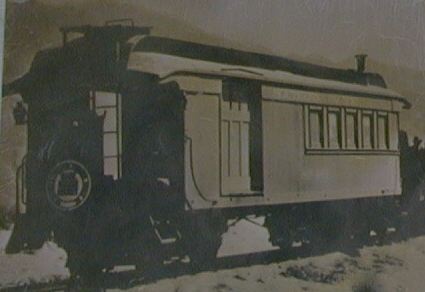 This is a very faded old photo of #401 in grander
days.
This is a very faded old photo of #401 in grander
days.
A fairly complete list of the loco and rolling
stock rosters are available at SPNG
Locomotive Roster and SPNG
Rolling Stock. These are photos of placards posted in the displays
at Laws. To be marginally readable, the photos are taken at high
resolution so the pictures are quite large.
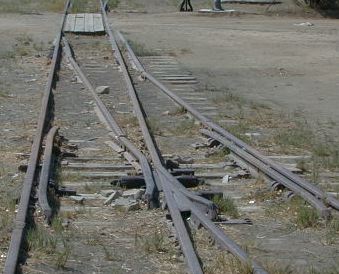 Laws was a major depot on the SP Narrow Gauge and there
are still some service facilities there. This is a typical stub switch
however it is not currently functional. The lead rails (at the top of
the picture) are now pinned in a grade crossing and cannot be moved to
match the diverging rails.
Laws was a major depot on the SP Narrow Gauge and there
are still some service facilities there. This is a typical stub switch
however it is not currently functional. The lead rails (at the top of
the picture) are now pinned in a grade crossing and cannot be moved to
match the diverging rails.
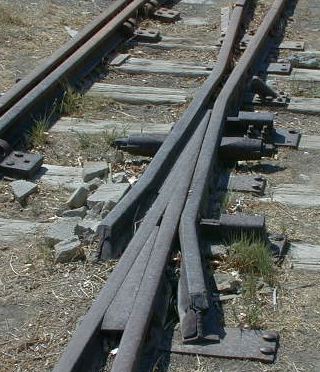 If you look carefully at the stub switch, you will find
that it has a sprung frog. I've never seen a sprung frog before and for
the life of me, I can't see why they would need one on a stub switch
where the "point" end cannot be sprung.
If you look carefully at the stub switch, you will find
that it has a sprung frog. I've never seen a sprung frog before and for
the life of me, I can't see why they would need one on a stub switch
where the "point" end cannot be sprung.
Paul Westover writes "I wanted to explain the use of the spring
frog in one of you're [sic] photos. The spring frog was developed to
lesson the impact loads of wheel treads across the flangeway.....by
using a spring frog with the wing rail snuggly seated against the point
this creates a continuous running surface for the wheels of passing
trains to ride across versus the wheel having to cross over the
flangeway of a typical rigid bolted frog or the RBM frog...(rail bound
manganese). The use of the spring frog fell from widespread use due to
its maintenance....but now has gained more popularity with the
development of better construction methods."
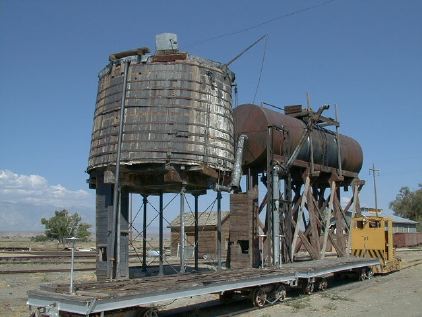 Just south of the stub switch is an engine
fueling facility. Since all the engines were oil fired, an old tank car
is raised on stilts to provide fuel oil. A more conventional water
tower is also here, but it looks like that it could no longer hold any
water.
Just south of the stub switch is an engine
fueling facility. Since all the engines were oil fired, an old tank car
is raised on stilts to provide fuel oil. A more conventional water
tower is also here, but it looks like that it could no longer hold any
water.
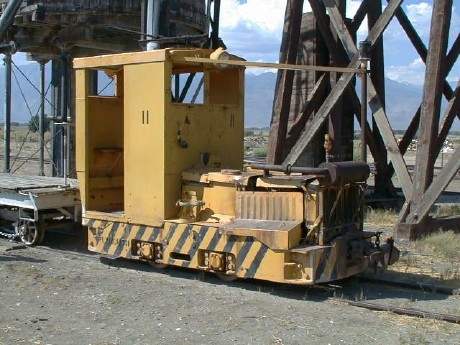 The critter sitting next to the
water tower is a gas mechanical Plymouth. It is operational and is used
to hostle equipment around the museum.
The critter sitting next to the
water tower is a gas mechanical Plymouth. It is operational and is used
to hostle equipment around the museum.
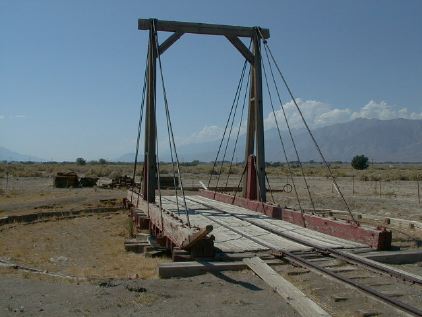 There is a well preserved armstrong type gallows
turntable at the sound end of the property. This prototype can be found
on many small railroads. The large handle at the lower left is the
turning mechanism. If the engine was centered and balanced properly,
two men could turn it.
There is a well preserved armstrong type gallows
turntable at the sound end of the property. This prototype can be found
on many small railroads. The large handle at the lower left is the
turning mechanism. If the engine was centered and balanced properly,
two men could turn it.
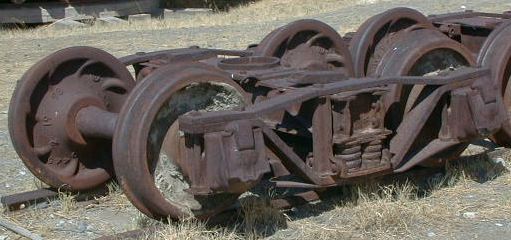 All of the SPNG freight equipment ran on archbar
type trucks. This design was popular until around the turn of the
century as it could be fabricated from sheet and bar stock, bolts,
rivets and sometimes wood beams. Only the relatively small journal
boxes and wheels are cast parts. The downside of the design is that it
wasn't very strong and a broken bar, bolt or rivet would usually cause
the truck to collapse and result in a derailment.
All of the SPNG freight equipment ran on archbar
type trucks. This design was popular until around the turn of the
century as it could be fabricated from sheet and bar stock, bolts,
rivets and sometimes wood beams. Only the relatively small journal
boxes and wheels are cast parts. The downside of the design is that it
wasn't very strong and a broken bar, bolt or rivet would usually cause
the truck to collapse and result in a derailment.
[ Home ] [ Up to Index ] [ Previous Page ] [ Next Page ]
© 1999-2006 George Schreyer
Created 25 Aug 1999
Last Updated July 8, 2008
 Locomotive No. 9, a 4-6-0, was built by the Baldwin Locomotive
Works, November 1909 for the Nevada-Calif.-Oregon Railway as their No.
9. It was acquired by the Southern Pacific Railroad, September 1, 1929,
rebuilt and put in service on the Owens Valley line Feb. 21 1930 as the
S P No. 9. It was put on stand-by service when the diesel electric
locomotive was put in service, Oct. 1954, was retired when the railroad
was abandoned. The locomotive was donated to the City of Bishop and
moved to Laws for display, April 30, 1960.
Locomotive No. 9, a 4-6-0, was built by the Baldwin Locomotive
Works, November 1909 for the Nevada-Calif.-Oregon Railway as their No.
9. It was acquired by the Southern Pacific Railroad, September 1, 1929,
rebuilt and put in service on the Owens Valley line Feb. 21 1930 as the
S P No. 9. It was put on stand-by service when the diesel electric
locomotive was put in service, Oct. 1954, was retired when the railroad
was abandoned. The locomotive was donated to the City of Bishop and
moved to Laws for display, April 30, 1960. The engine is displayed at the head of a short train of
wood cars. The cab is open to visitors and the bell works fine. Every
kid that climbed in the cab rings the bell.
The engine is displayed at the head of a short train of
wood cars. The cab is open to visitors and the bell works fine. Every
kid that climbed in the cab rings the bell. Most SP engines ran on oil as
both wood and coal are rather scarce in the eastern Sierra. SP used the
lowest grade of oil that they could get and these locos smoked heavily
even when fired correctly.
Most SP engines ran on oil as
both wood and coal are rather scarce in the eastern Sierra. SP used the
lowest grade of oil that they could get and these locos smoked heavily
even when fired correctly. Following the engine in the
display, there is a well preserved wooden boxcar wearing the original
C&C lettering.
Following the engine in the
display, there is a well preserved wooden boxcar wearing the original
C&C lettering. A similar boxcar, this time
lettered for SP, follows the C&C car.
A similar boxcar, this time
lettered for SP, follows the C&C car. This side dump gondola was the next in line. These cars
were usually used for hauling ballast so that it could be dumped right
at the side of the tracks. The dump doors are as simple as they get.
Between each door is a piece of angle iron that is pivoted at the
center. The piece could be turned to either hold the doors shut or to
prop them open.
This side dump gondola was the next in line. These cars
were usually used for hauling ballast so that it could be dumped right
at the side of the tracks. The dump doors are as simple as they get.
Between each door is a piece of angle iron that is pivoted at the
center. The piece could be turned to either hold the doors shut or to
prop them open. The Slim Princess hauled
livestock that was grazed in the fairly dry ranches of the Owens Valley
north to the railhead at Mound House where the stock could be
transferred to the V&T and eventually to the rest of the SP
system.
The Slim Princess hauled
livestock that was grazed in the fairly dry ranches of the Owens Valley
north to the railhead at Mound House where the stock could be
transferred to the V&T and eventually to the rest of the SP
system. This car was built by the Carter Brothers Manufacturing
Company in 1881 for the San Joaquin and Sierra Nevada Railway, a
Southern Pacific subsidiary, as a baggage-coach for passenger service.
In 1888, it became the property of the Northern Railway, another
Southern Pacific subsidiary, as their number 1009, and in 1904 went to
Southern Pacific's South Pacific Coast Railway still numbered 1009.
This car was built by the Carter Brothers Manufacturing
Company in 1881 for the San Joaquin and Sierra Nevada Railway, a
Southern Pacific subsidiary, as a baggage-coach for passenger service.
In 1888, it became the property of the Northern Railway, another
Southern Pacific subsidiary, as their number 1009, and in 1904 went to
Southern Pacific's South Pacific Coast Railway still numbered 1009. This is a very faded old photo of #401 in grander
days.
This is a very faded old photo of #401 in grander
days. Laws was a major depot on the SP Narrow Gauge and there
are still some service facilities there. This is a typical stub switch
however it is not currently functional. The lead rails (at the top of
the picture) are now pinned in a grade crossing and cannot be moved to
match the diverging rails.
Laws was a major depot on the SP Narrow Gauge and there
are still some service facilities there. This is a typical stub switch
however it is not currently functional. The lead rails (at the top of
the picture) are now pinned in a grade crossing and cannot be moved to
match the diverging rails. If you look carefully at the stub switch, you will find
that it has a sprung frog. I've never seen a sprung frog before and for
the life of me, I can't see why they would need one on a stub switch
where the "point" end cannot be sprung.
If you look carefully at the stub switch, you will find
that it has a sprung frog. I've never seen a sprung frog before and for
the life of me, I can't see why they would need one on a stub switch
where the "point" end cannot be sprung. Just south of the stub switch is an engine
fueling facility. Since all the engines were oil fired, an old tank car
is raised on stilts to provide fuel oil. A more conventional water
tower is also here, but it looks like that it could no longer hold any
water.
Just south of the stub switch is an engine
fueling facility. Since all the engines were oil fired, an old tank car
is raised on stilts to provide fuel oil. A more conventional water
tower is also here, but it looks like that it could no longer hold any
water. The critter sitting next to the
water tower is a gas mechanical Plymouth. It is operational and is used
to hostle equipment around the museum.
The critter sitting next to the
water tower is a gas mechanical Plymouth. It is operational and is used
to hostle equipment around the museum. There is a well preserved armstrong type gallows
turntable at the sound end of the property. This prototype can be found
on many small railroads. The large handle at the lower left is the
turning mechanism. If the engine was centered and balanced properly,
two men could turn it.
There is a well preserved armstrong type gallows
turntable at the sound end of the property. This prototype can be found
on many small railroads. The large handle at the lower left is the
turning mechanism. If the engine was centered and balanced properly,
two men could turn it. All of the SPNG freight equipment ran on archbar
type trucks. This design was popular until around the turn of the
century as it could be fabricated from sheet and bar stock, bolts,
rivets and sometimes wood beams. Only the relatively small journal
boxes and wheels are cast parts. The downside of the design is that it
wasn't very strong and a broken bar, bolt or rivet would usually cause
the truck to collapse and result in a derailment.
All of the SPNG freight equipment ran on archbar
type trucks. This design was popular until around the turn of the
century as it could be fabricated from sheet and bar stock, bolts,
rivets and sometimes wood beams. Only the relatively small journal
boxes and wheels are cast parts. The downside of the design is that it
wasn't very strong and a broken bar, bolt or rivet would usually cause
the truck to collapse and result in a derailment.